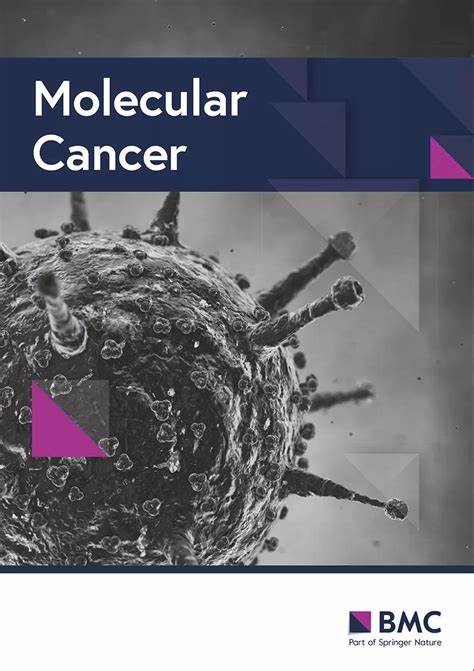肝细胞癌的单细胞肿瘤异质性图谱:揭示促转移亚型及其与成纤维细胞的相互作用环路
IF 27.7
1区 医学
Q1 BIOCHEMISTRY & MOLECULAR BIOLOGY
引用次数: 0
摘要
肿瘤的异质性给了解肿瘤进展和转移的驱动机制带来了巨大挑战。肝细胞癌(HCC)在细胞水平上的异质性尚不清楚。研究人员对单细胞 RNA 测序数据和空间转录组学数据进行了整合分析。应用多种方法研究了 HCC 肿瘤细胞的亚型。分析了不同亚型肿瘤细胞的功能特征、翻译因子、临床意义和微环境关联。分析了亚型与成纤维细胞的相互作用。我们通过整合 52 个单细胞 RNA 测序数据和 5 个空间转录组学数据,建立了 HCC 恶性细胞的异质性图谱。我们在肿瘤细胞中发现了三种亚型,包括ARG1+代谢亚型(Metab-subtype)、TOP2A+增殖表型(Prol-phenotype)和S100A6+促转移亚型(EMT-subtype)。富集分析发现,这三种亚型具有不同的特征,即新陈代谢、增殖和上皮-间质转化。轨迹分析表明,代谢亚型和 EMT 亚型都源自 Prol 表型。翻译因子分析发现,EMT亚型显示出SMAD3和TGF-β信号通路的独家激活。以 EMT 亚型细胞为主的 HCC 预后不良,微环境荒芜。我们发现了肿瘤细胞与成纤维细胞之间由 SPP1-CD44 和 CCN2/TGF-β-TGFBR1 相互作用对介导的正循环。抑制CCN2可破坏这一循环,减轻向EMT亚型的转化,并抑制转移。通过建立恶性细胞的异质性图谱,我们确定了HCC的三亚型分类。其中,S100A6+肿瘤细胞在转移中起着至关重要的作用。针对肿瘤细胞和成纤维细胞之间的反馈回路是一种很有前景的抗转移策略。本文章由计算机程序翻译,如有差异,请以英文原文为准。
Single-cell tumor heterogeneity landscape of hepatocellular carcinoma: unraveling the pro-metastatic subtype and its interaction loop with fibroblasts
Tumor heterogeneity presents a formidable challenge in understanding the mechanisms driving tumor progression and metastasis. The heterogeneity of hepatocellular carcinoma (HCC) in cellular level is not clear. Integration analysis of single-cell RNA sequencing data and spatial transcriptomics data was performed. Multiple methods were applied to investigate the subtype of HCC tumor cells. The functional characteristics, translation factors, clinical implications and microenvironment associations of different subtypes of tumor cells were analyzed. The interaction of subtype and fibroblasts were analyzed. We established a heterogeneity landscape of HCC malignant cells by integrated 52 single-cell RNA sequencing data and 5 spatial transcriptomics data. We identified three subtypes in tumor cells, including ARG1+ metabolism subtype (Metab-subtype), TOP2A+ proliferation phenotype (Prol-phenotype), and S100A6+ pro-metastatic subtype (EMT-subtype). Enrichment analysis found that the three subtypes harbored different features, that is metabolism, proliferating, and epithelial-mesenchymal transition. Trajectory analysis revealed that both Metab-subtype and EMT-subtype originated from the Prol-phenotype. Translation factor analysis found that EMT-subtype showed exclusive activation of SMAD3 and TGF-β signaling pathway. HCC dominated by EMT-subtype cells harbored an unfavorable prognosis and a deserted microenvironment. We uncovered a positive loop between tumor cells and fibroblasts mediated by SPP1-CD44 and CCN2/TGF-β-TGFBR1 interaction pairs. Inhibiting CCN2 disrupted the loop, mitigated the transformation to EMT-subtype, and suppressed metastasis. By establishing a heterogeneity landscape of malignant cells, we identified a three-subtype classification in HCC. Among them, S100A6+ tumor cells play a crucial role in metastasis. Targeting the feedback loop between tumor cells and fibroblasts is a promising anti-metastatic strategy.
求助全文
通过发布文献求助,成功后即可免费获取论文全文。
去求助
来源期刊

Molecular Cancer
医学-生化与分子生物学
CiteScore
54.90
自引率
2.70%
发文量
224
审稿时长
2 months
期刊介绍:
Molecular Cancer is a platform that encourages the exchange of ideas and discoveries in the field of cancer research, particularly focusing on the molecular aspects. Our goal is to facilitate discussions and provide insights into various areas of cancer and related biomedical science. We welcome articles from basic, translational, and clinical research that contribute to the advancement of understanding, prevention, diagnosis, and treatment of cancer.
The scope of topics covered in Molecular Cancer is diverse and inclusive. These include, but are not limited to, cell and tumor biology, angiogenesis, utilizing animal models, understanding metastasis, exploring cancer antigens and the immune response, investigating cellular signaling and molecular biology, examining epidemiology, genetic and molecular profiling of cancer, identifying molecular targets, studying cancer stem cells, exploring DNA damage and repair mechanisms, analyzing cell cycle regulation, investigating apoptosis, exploring molecular virology, and evaluating vaccine and antibody-based cancer therapies.
Molecular Cancer serves as an important platform for sharing exciting discoveries in cancer-related research. It offers an unparalleled opportunity to communicate information to both specialists and the general public. The online presence of Molecular Cancer enables immediate publication of accepted articles and facilitates the presentation of large datasets and supplementary information. This ensures that new research is efficiently and rapidly disseminated to the scientific community.
 求助内容:
求助内容: 应助结果提醒方式:
应助结果提醒方式:


